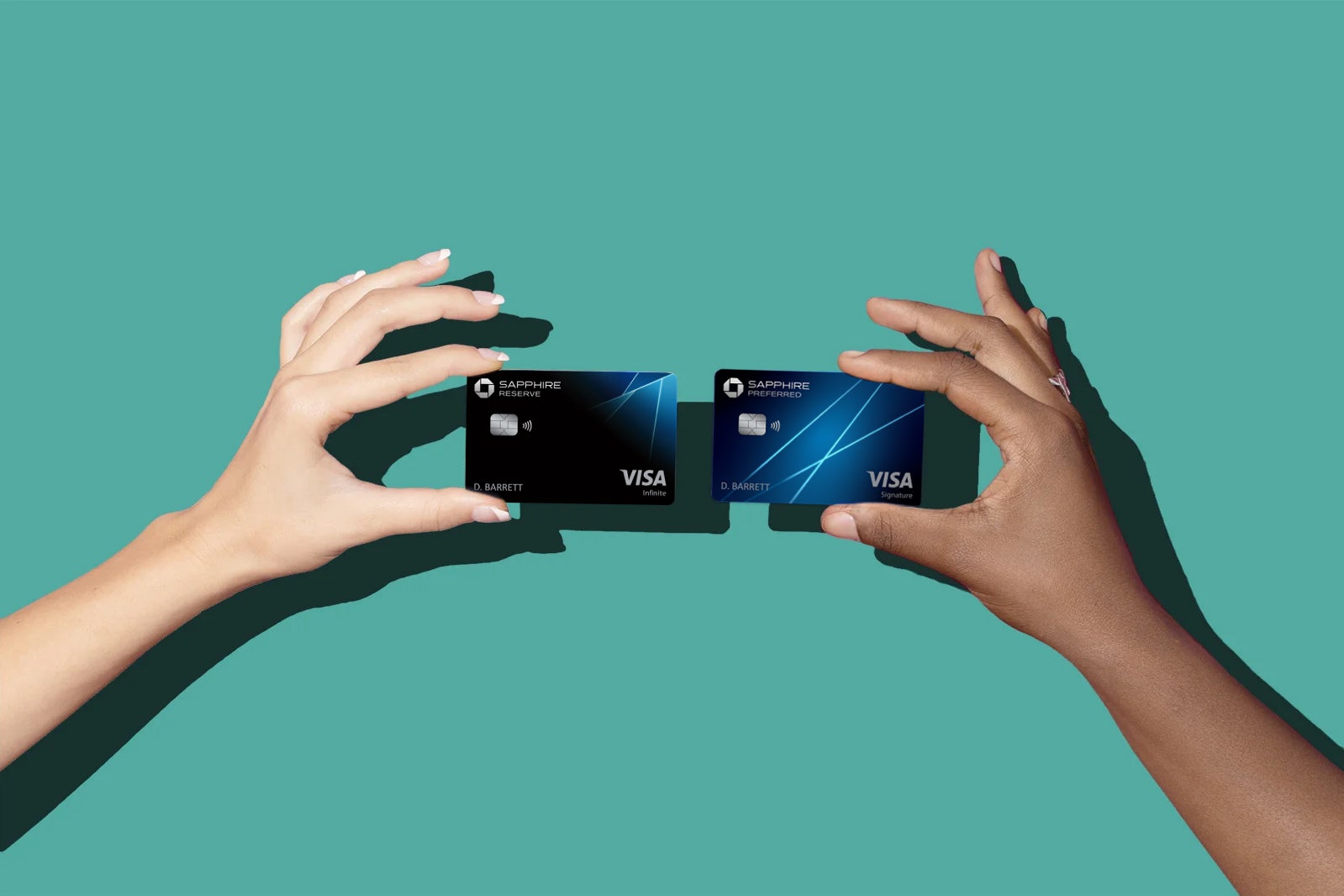Chase Sapphire Preferred vs. Sapphire Reserve: Should you go mid-tier or premium?
The Chase Sapphire Reserve® and the Chase Sapphire Preferred® Card are two of the most talked-about travel credit cards on the market. That’s thanks to the valuable Ultimate Rewards program, top-notch benefits and great travel protections. But which one is the best match for you?
You might assume that the Chase Sapphire Reserve — with a higher annual fee and more luxury benefits — is always the better choice. It is the higher-tier card, but that may not necessarily mean it’s your best option. Depending on your spending habits, travel goals and existing credit card lineup, the Sapphire Preferred could be the more attractive option for your wallet.
We’ll compare the two cards below to help you make the best decision.
Sapphire Preferred vs. Sapphire Reserve comparison
Card |
Chase Sapphire Preferred |
Chase Sapphire Reserve |
|---|---|---|
| Annual fee | $95 | $550 |
| Earning rates | 5 points per dollar on travel purchased through the Chase Travel portal
5 points per dollar on Lyft through March 2025 5 points per dollar on Peloton equipment and accessory purchases over $150 or more with a maximum earn of 25,000 total points through March 2025 3 points per dollar on dining at restaurants worldwide, online grocery purchases, and select streaming services 2 points per dollar on all other travel 1 point per dollar on everything else |
10 points per dollar on hotels, car rentals and Chase Dining purchased through the Chase Travel portal
10 points per dollar on Lyft through March 2025 10 points per dollar on Peloton equipment and accessory purchases over $150 with a maximum earn of 50,000 total points through March 2025 5 points per dollar on flights purchased through the Chase Travel portal 3 points per dollar on dining and all other travel 1 point per dollar on everything else |
| Sign-up bonus | 75,000 bonus points after you spend $4,000 on purchases in the first three months from account opening | 75,000 bonus points after you spend $4,000 on purchases in the first three months from account opening |
| Value for Ultimate Rewards travel redemptions | 1.25 cents | 1.5 cents |
| Benefits | $50 annual Chase Travel hotel credit
10% anniversary points boost DoorDash DashPass subscription (activate by Dec. 31) Six-month complimentary Instacart+ membership (activate by July 31) and up to $15 in Instacart statement credits each quarter (through July 31)
|
$300 annual travel credit
Global Entry, TSA PreCheck or Nexus fee credit (up to $100) every four years Complimentary two-year Lyft Pink All Access membership (activate by Dec. 31) DoorDash DashPass subscription (activate by Dec. 31) and $5 in DoorDash credits each month One-year complimentary Instacart+ membership (activate by July 31) and up to $15 in Instacart statement credits per month (through July 31) Access to Chase Luxury Hotel & Resort Collection |
| Lounge access | None | Priority Pass lounges
Sapphire Lounges |
| Authorized user annual fee | $0 | $75 for each user |
Sapphire Preferred vs. Sapphire Reserve welcome bonus
Currently, the Sapphire Preferred and Sapphire Reserve have an identical welcome bonus of 75,000 points after you spend $4,000 in the first three months from account opening.
TPG values Chase Ultimate Rewards points at 2.05 cents each, making these bonuses worth $1,538.
But remember that you’re only eligible for a welcome bonus on one of these cards if you haven’t received a bonus from one within the past 48 months. Additionally, both cards are subject to Chase’s 5/24 rule, so make sure you’re eligible for both the card and its bonus before applying.
Winner: Tie. Both cards currently have identical welcome bonuses.
Related: The best time to apply for these Chase cards based on their offer history
Sapphire Preferred vs. Sapphire Reserve benefits
The difference in benefits is where the Sapphire Reserve shines. With it, you’ll get a $300 annual travel credit and access to Chase Lounges and Priority Pass lounges (including access to Priority Pass restaurants through June). Cardholders also receive a Global Entry, TSA PreCheck or Nexus fee credit of up to $100 every four years, which will increase to $120 when the Global Entry fee changes in October.

Daily Newsletter
Reward your inbox with the TPG Daily newsletter
Join over 700,000 readers for breaking news, in-depth guides and exclusive deals from TPG’s experts
Additionally, the Sapphire Reserve comes with a complimentary two-year Lyft Pink All Access membership (activate by Dec. 31), a complimentary DoorDash DashPass subscription for at least one year (activate by Dec. 31) as well as $5 in DoorDash credits each month, one year of complimentary Instacart+ (activate by July 31) and up to $15 in Instacart statement credits per month through July 31.
Plus, the Sapphire Reserve gets you access to Chase’s Luxury Hotel & Resort Collection, which includes benefits like daily breakfast for two and a $100 on-property credit for each booking.
Still, the Sapphire Preferred comes with a handful of benefits. With it, you’ll get an annual $50 credit for hotels booked through the Chase Travel portal and an account anniversary points bonus of 10% of the total purchases you made that year. You’ll also get a complimentary DoorDash DashPass subscription for at least one year (activate by Dec. 31), six months of complimentary Instacart+ membership (activate by July 31), and up to $15 in Instacart statement credits each quarter through July 31.
While both cards have impressive travel and purchase protections, the Sapphire Reserve’s protections are more substantial. For example, trip cancellation insurance on the Sapphire Preferred covers up to $10,000 per covered trip, whereas the Sapphire Reserve covers up to $20,000 per covered trip. The Sapphire Reserve also offers elevated coverage for rental car insurance, trip delay protection, emergency medical and dental insurance, and purchase protection.
Winner: Sapphire Reserve. The travel credit, airport lounge access and elevated travel protections are hard to beat.
Related: Is the Chase Sapphire Reserve worth the annual fee?
Earning points with the Sapphire Preferred vs. Sapphire Reserve
The Sapphire Preferred earns five points per dollar on travel booked through the Chase Travel portal, Lyft rides (through March 2025) and Peloton equipment and accessory purchases over $150 (with a max earn of 25,000 total points, through March 2025). It also earns three points per dollar on dining, online grocery and select streaming purchases, as well as two points per dollar on eligible travel purchases and one point per dollar on all other purchases.
The Sapphire Reserve, meanwhile, earns 10 points per dollar on hotels, car rentals and Chase Dining purchased through the Chase Travel portal, Lyft rides (through March 2025) and Peloton equipment and accessory purchases over $150 (with a max earn of 50,000 total points, through March 2025). It earns five points per dollar on flights purchased through the Chase Travel portal, three points per dollar on dining and travel purchases and one point per dollar on all other purchases.
Winner: Sapphire Reserve. It earns more than the Preferred in most bonus categories.
Related: Which purchases count as travel with the Chase Sapphire Preferred and Chase Sapphire Reserve?
Redeeming points with the Sapphire Preferred vs. Sapphire Reserve
Since both the Sapphire Preferred and the Sapphire Reserve earn Chase Ultimate Rewards points, you’ll have the same redemption options with either card. Your most valuable redemption option is to transfer them to any of Chase’s 14 airline and hotel partners for the most value, but you can also use them to book travel through the Ultimate Rewards portal or use Chase’s Pay Yourself Back option.
Additionally, you can redeem your points for cash back or gift cards, but you’ll get a lower value from your points going this route, so we recommend using your points for travel when you can.
However, if you’re redeeming your points through the Chase Travel portal or using Chase Pay Yourself Back, your points are worth more with the Sapphire Reserve. With it, you’ll get a value of 1.5 cents per point, while you’ll only get a value of 1.25 cents per point with the Sapphire Preferred.
Winner: Sapphire Reserve. The higher redemption value through the Ultimate Rewards portal and Pay Yourself Back give the Reserve an edge.
Related: How to redeem Chase Ultimate Rewards for maximum value
Transferring points with the Sapphire Preferred vs. Sapphire Reserve
Both the Sapphire Preferred and Sapphire Reserve allow you to transfer your points to any of Chase’s 14 travel partners. Some of the most valuable partners include Air France-KLM Flying Blue, Air Canada Aeroplan and World of Hyatt.
Credit card writer Danyal Ahmed loves transferring his points to Aeroplan to take advantage of their region and distance-based award chart along with their impressive list of non-Star Alliance partners.
Winner: Tie. You’ll get the same transfer options with either card.
Related: The complete guide to Chase Ultimate Rewards transfer partners
Should I get the Sapphire Preferred or the Sapphire Reserve?
If you can take advantage of the annual travel credit and don’t have another card that includes airport lounge access, you’ll almost certainly get the most value from the Sapphire Reserve. However, if you want to keep your annual fee costs low or don’t travel much, the Sapphire Preferred will give you good earning rates and redemption options for a much lower annual fee.
Related: 11 reasons to choose the Sapphire Preferred over the Sapphire Reserve
How to upgrade from the Sapphire Preferred to the Sapphire Reserve
If you have the Sapphire Preferred and want the Sapphire Reserve instead, the best strategy is to first downgrade your Preferred to a no-annual-fee Chase card like the Chase Freedom Unlimited®. You can request this by calling the number on the back of your card. Then, you can apply for the Sapphire Reserve and earn the welcome bonus, as long as you are under Chase’s 5/24 rule and did not earn the bonus on your Chase Sapphire Preferred less than 48 months ago.
Likewise, you can downgrade your Reserve to a Preferred card by calling the number on the back of your card. However, you will miss out on the welcome bonus on the Preferred, so it’s better to downgrade your Reserve to a no-annual-fee card first and then submit a new application for the Preferred to earn the welcome bonus so as long as you did not earn the welcome bonus on the Sapphire Reserve less than 48 months prior.
You can also request a product change from either card to the other by calling the number on the back of your card. However, by going this route, you’ll forfeit earning a welcome bonus on your new card.
Related: 5 reasons to upgrade from the Sapphire Preferred to the Sapphire Reserve
Bottom line
The Chase Sapphire Preferred and Chase Sapphire Reserve are TPG favorites for their strong earning rates, extensive travel protections and valuable transfer partners. Which card is better for you depends on your travel goals and spending habits, but you can’t go wrong with either card.
For more details, please see our full reviews of the Chase Sapphire Preferred and Chase Sapphire Reserve.
Apply here: Chase Sapphire Preferred Card
Apply here: Chase Sapphire Reserve













